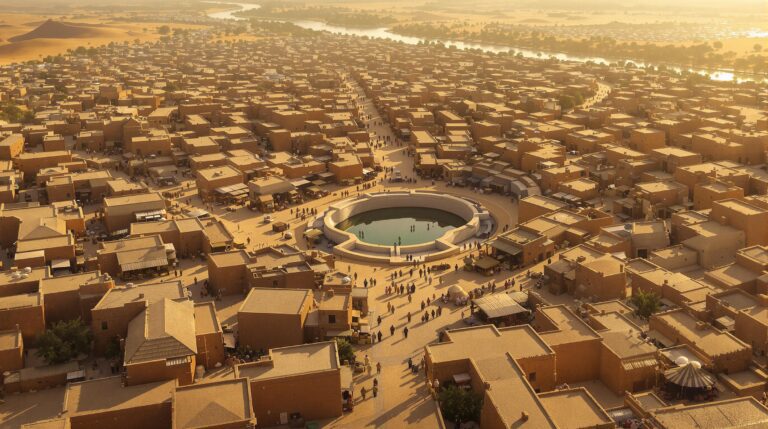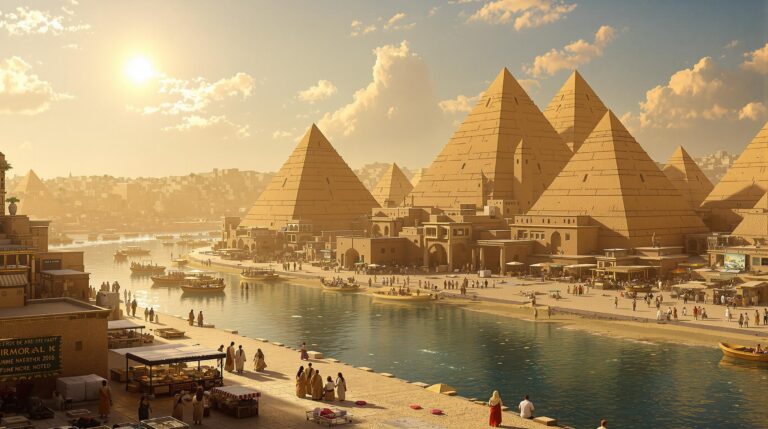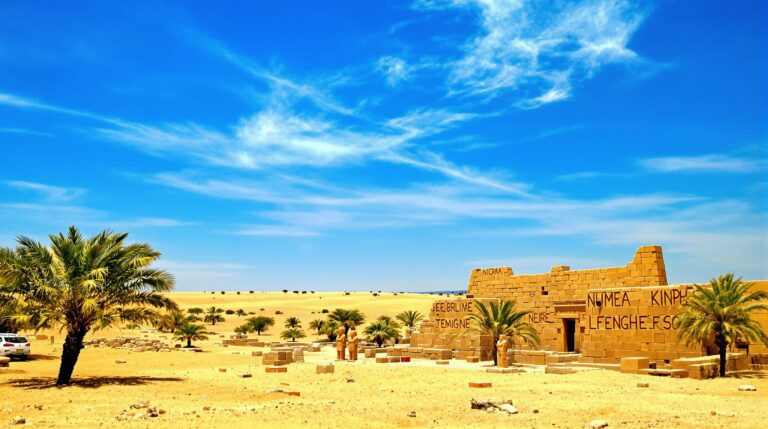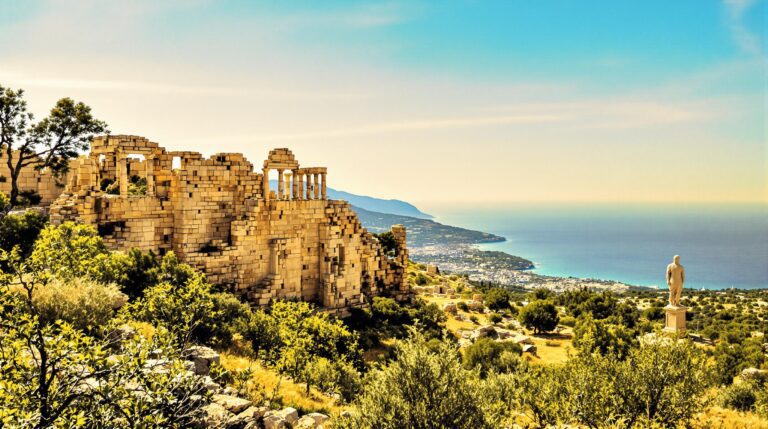Ancient Anatolia: Göbekli Tepe & Beyond
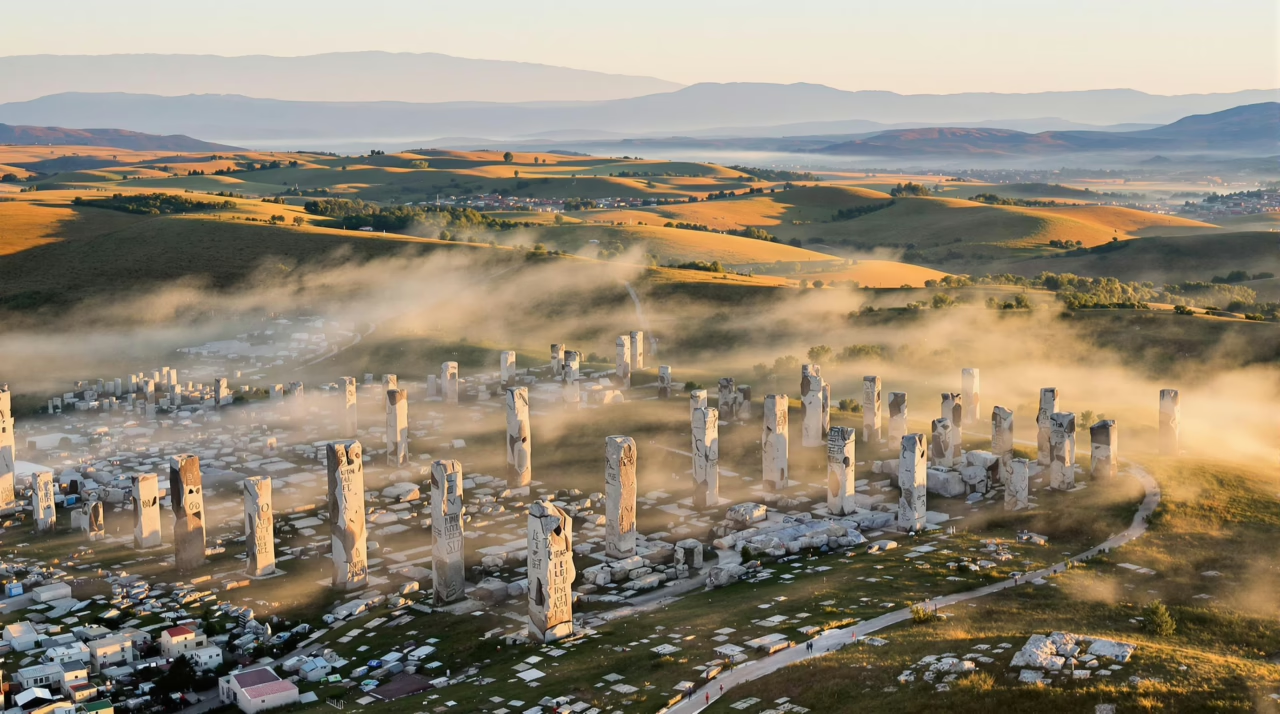
Ancient Anatolia presents a fascinating tapestry of human history, marked by significant sites like Göbekli Tepe.
This monumental complex raises questions about the sophistication of early societies long before agriculture took hold.
What drove people to construct such elaborate structures? How did these early communities navigate their beliefs and social structures?
As we explore the interconnectedness of places like Çatalhöyük and Hattusa, the narrative of civilization’s origins becomes increasingly intricate and compelling.
Principal Conclusions
Hide- Göbekli Tepe's megaliths reveal complex belief systems predating agriculture, reshaping understanding of early human civilization in Anatolia.
- Çatalhöyük's unique layout and communal spaces illustrate social dynamics and daily practices among its inhabitants.
- Hattusa served as a fortified urban center, strategically positioned along ancient trade routes, enhancing its military and political significance.
- Cuneiform writing in Hittite governance revolutionized administration, preserving legal codes and historical records essential for societal order.
- Cultural exchanges through trade routes facilitated innovation and the evolution of religious practices, linking ancient Anatolia to surrounding civilizations.
Göbekli Tepe: The Mysterious Megaliths
Göbekli Tepe stands as a testament to human ingenuity, its megaliths emerging from the earth like whispers of a forgotten civilization.
How could such monumental architecture arise in a time before the advent of agriculture, and what does this suggest about the social and spiritual frameworks of its builders?
The symbolism embedded within these stones invites a deeper exploration of the belief systems that may have shaped early human society in this enigmatic site.
Discovery and Excavation of a Prehistoric Wonder
In the 1990s, the serendipitous discovery of Göbekli Tepe revealed a site that challenged conventional understandings of prehistoric human society.
Key archaeologists, drawn to its enigmatic megaliths, initiated ongoing fieldwork that continuously reshapes the narrative of early civilization.
What secrets lie within these ancient stones, and how might they redefine humanity’s journey from nomadic tribes to settled communities?
How Göbekli Tepe was found in the 1990s
Unearthed in the 1990s, the site of Göbekli Tepe has captivated archaeologists and historians alike, raising questions about the complexities of early human civilization.
Its discovery revealed:
- Monumental stone structures predating known societies
- Intricate carvings of animals and symbols
- Implications for social organization and religious practices
Such findings challenge conventional timelines and encourage a reevaluation of humanity’s shared narrative, igniting curiosity about our origins.
Key archaeologists and ongoing fieldwork
The discovery of Göbekli Tepe sparked a renewed interest in the figures behind its excavation and the ongoing research that seeks to unravel its mysteries.
Notable archaeologists, like Klaus Schmidt, have profoundly shaped our understanding of this site.
Current fieldwork continues to reveal intricate carvings and monumental structures, inviting questions about the societal structures and spiritual beliefs of its ancient builders.
Ultimately, this ongoing research is reshaping our perception of early human civilization.
Monumental Architecture Without Agriculture
The T-shaped pillars of Göbekli Tepe, adorned with intricate carvings, prompt a reevaluation of Neolithic society’s complexities.
How could such monumental architecture emerge in a context devoid of agriculture, challenging long-held beliefs about the prerequisites of social organization?
This enigmatic site not only raises questions about the role of ritual and communal activity in early human civilization but also invites further exploration into the motivations behind its construction.
Significance of T-shaped pillars and carvings
Mystery surrounds the T-shaped pillars and intricate carvings of Göbekli Tepe, inviting scholars and enthusiasts alike to explore their profound significance.
These megaliths may represent:
- Spirituality: A connection to the divine or ancestral worship.
- Social Structure: Indicators of community organization and collaboration.
- Cultural Expression: Art that conveys the beliefs and values of early humans.
Their meanings provoke curiosity about humanity’s origins.
Challenging assumptions about Neolithic society
While many scholars have long assumed that monumental architecture emerged only in societies with established agricultural practices, Göbekli Tepe offers a striking counterexample that challenges this perspective.
This site suggests that social complexity and communal effort can precede agriculture, raising questions about Neolithic societal structures.
How did these early builders organize labor and resources? What does this imply about human creativity and cooperation?
Symbolism and Belief Systems
The intricate animal motifs adorning the megaliths of Göbekli Tepe raise compelling questions about the belief systems of its builders.
What might these depictions reveal about their spiritual or religious practices, and how did they influence social dynamics within this enigmatic community?
As scholars propose various theories regarding the ceremonial functions of these monumental structures, the intersection of symbolism and societal structure emerges as a critical area for exploration.
Animal motifs and possible religious meanings
Animal motifs carved into the megaliths of Göbekli Tepe invite a deep exploration into the spiritual and cultural landscapes of ancient Anatolian societies.
These intricate designs may hint at significant religious beliefs, revealing:
- Connections to fertility and abundance
- Symbolic representations of power and protection
- Expressions of the relationship between humans and nature
Such motifs provoke questions about the shared values and collective consciousness of these early communities.
Theories on ceremonial or social functions
Göbekli Tepe stands as a monumental evidence to the complex social and ceremonial functions that may have characterized early Anatolian communities.
Scholars propose that its massive stone structures served as gathering places for rituals, fostering social cohesion.
These megaliths, adorned with intricate carvings, evoke questions about belief systems, communal identity, and the interplay between spirituality and social organization in prehistoric societies.
Çatalhöyük: One of the Earliest Urban Centers
Çatalhöyük stands as a remarkable proof of early urban life, characterized by its intricate layout and communal living arrangements that challenge modern notions of individuality.
Its diverse array of artistic expression reveals insights into the daily practices and spiritual beliefs of its inhabitants, prompting questions about the role of creativity in societal cohesion.
What can the distinctive architecture and lively artwork of this ancient settlement teach contemporary society about the connections between environment, community, and cultural identity?
Unique Layout and Community Living
Çatalhöyük presents a fascinating case of early urban living, characterized by its rooftop access and the absence of conventional streets.
This unique layout raises intriguing questions about social interaction and communal life, as residents navigated their environment atop interconnected structures.
How might these shared spaces have influenced domestic relationships and collective identity within one of humanity’s first urban centers?
Rooftop access and lack of streets
The unique architectural design of one of the earliest urban centers in Anatolia invites curiosity about its social dynamics and functionality.
Çatalhöyük’s layout, characterized by rooftop access and the absence of streets, raises intriguing questions:
- How did this influence social interactions?
- What implications did it have for community safety?
- Did it foster a sense of unity among inhabitants?
Such features reflect a distinctive approach to urban living.
Shared spaces and domestic life
In the heart of ancient Anatolia, shared spaces played a pivotal role in shaping domestic life within one of the earliest urban centers.
At Çatalhöyük, interconnected homes fostered a sense of community, blurring the lines between private and public domains. This unique layout encouraged collaboration and social interaction, prompting questions about the nature of communal living and the profound impact of shared environments on human relationships.
Artistic Expression and Daily Practice
In Çatalhöyük, the vibrancy of artistic expression manifests through intricate wall paintings, diverse figurines, and elaborate burial customs, prompting questions about their significance in daily life.
How did these artworks and rituals reflect the community’s beliefs and social structures?
The role of symbolism in these early Anatolian homes invites a deeper exploration of the interconnectedness between art and the lived experiences of its inhabitants.
Wall paintings, figurines, and burial customs
Artistic expression in Çatalhöyük reveals profound insights into the lives and beliefs of one of humanity’s earliest urban centers.
The wall paintings, figurines, and burial customs provide a window into their complex society. Remarkable elements include:
- Intricate murals depicting daily life and rituals
- Figurines possibly representing fertility or deities
- Elaborate burial practices reflecting beliefs in the afterlife
These artifacts invite contemplation of human existence.
Role of symbolism in early Anatolian homes
The intricate symbolism woven into the fabric of Çatalhöyük’s homes reflects a society deeply engaged with meaning and representation.
From lively wall murals to the placement of figurines, each element served as a narrative, expressing beliefs and social structures.
Such artistic expressions invite contemplation: what stories reside within these walls?
How did symbolism foster community identity and continuity in this early urban center?
Hattusa: Capital of the Hittite Empire
Hattusa, strategically perched at the crossroads of ancient trade routes, emerged as a formidable capital of the Hittite Empire, raising questions about the interplay between geography and political power.
The discovery of extensive written records and legal codes from this era invites exploration into how these documents shaped governance and societal norms.
What implications did Hattusa‘s location and its sophisticated bureaucratic systems have on the broader tapestry of Anatolian civilization?
Strategic Location and Rise to Power
The strategic geography of Hattusa, perched amidst the rugged terrain of Anatolia, offered both natural defenses and control over essential trade routes.
This unique positioning, complemented by sophisticated military architecture, played a significant role in the ascendancy of the Hittite kings, who expertly leveraged their resources to establish a formidable empire.
How did these factors intertwine to shape the political and military landscape of the ancient world?
Geography and defensive architecture
Although many ancient cities were built with an eye toward natural defenses, Hattusa stands out due to its remarkable strategic location and innovative architecture.
This capital of the Hittite Empire boasts:
- Elevated terrain providing vantage points
- Massive stone walls for formidable protection
- Intricate gateways that control access
These features not only fortified Hattusa but also symbolized the empire’s power, inviting deeper contemplation of its historical significance.
Hittite kings and military structure
Frequently, the military prowess of the Hittite Empire can be traced back to the strategic decisions made by its kings, who deftly navigated the complex interplay of power, warfare, and diplomacy.
The administrative structure, with its emphasis on a professional army and fortified cities, allowed for rapid mobilization. This adaptability enabled Hittite rulers to expand their influence, securing crucial trade routes and territorial dominance.
Written Records and Legal Codes
In Hattusa, the capital of the Hittite Empire, the emergence of cuneiform writing revolutionized administrative practices and recorded history.
What insights might the royal archives and the intricate tapestry of diplomatic treaties reveal about the complexities of Hittite governance and their interactions with neighboring states?
The legal codes inscribed within these ancient texts not only reflect societal norms but also prompt reflections on the evolution of justice and authority in one of history’s earliest civilizations.
Use of cuneiform and royal archives
Cuneiform, the ancient script of the Near East, served as an essential instrument for the administration of the Hittite Empire, particularly in its capital, Hattusa.
This script facilitated:
- The documentation of legal codes, ensuring societal order.
- The management of royal archives, preserving history.
- The recording of economic transactions, underpinning trade.
How did these written records shape Hittite governance and culture?
The implications are profound.
Diplomatic treaties and administrative systems
Although the Hittite Empire thrived amidst a complex web of alliances and rivalries, the sophistication of its diplomatic treaties and administrative systems reveals a remarkable level of governance that transcended mere military might.
These treaties, meticulously documented, reflected not only power dynamics but also cultural exchanges, while legal codes established a framework for societal order, fostering stability and promoting the idea of collective responsibility among diverse populations.
Troy: Between Myth and History
The archaeological site of Troy presents a fascinating intersection of legend and historical reality, with its layered ruins telling stories of civilizations that rose and fell over millennia.
As researchers sift through the remnants, they uncover not only the material culture of the ancient Trojans but also the profound influence this site had on the broader cultural tapestry of Anatolia.
Could it be that the echoes of myth and history are inextricably intertwined, shaping the identities of those who came after?
Layers of Civilization Beneath the Ruins
The layers of civilization at Troy, from Troy I to Troy IX, present a fascinating tapestry of human history that intertwines myth with reality.
Each stratum reveals archaeological controversies, sparking debates among scholars about the veracity of legendary tales versus tangible evidence.
What insights can these remnants provide about the cultural evolution and societal complexities of this ancient metropolis?
Different levels from Troy I to Troy IX
Layers of civilization lie buried beneath the ancient site of Troy, each stratum revealing a unique chapter in a complex narrative of human history.
- Troy I: A modest settlement, hinting at early urbanization.
- Troy VI: Flourishing trade center, showcasing wealth and culture.
- Troy IX: A fortified stronghold, reflecting changing geopolitical dynamics.
What stories do these layers whisper to today’s seekers of truth?
Archaeological controversies and insights
Amidst the intricate tapestry of Troy’s history, archaeological debates continue to swirl, challenging established narratives and inviting fresh interpretations.
The dichotomy between myth and reality raises questions about the city’s legendary status. Excavations reveal layers of civilization, yet conflicting findings provoke discussions on timelines, cultural exchanges, and the interpretation of artifacts, urging scholars to reconsider the complexities of Trojian identity and its historical significance.
Influence on Anatolia’s Cultural Ties
The intricate tapestry of trade connections in ancient Anatolia raises compelling questions about the cultural exchanges that shaped its civilizations, particularly in the context of Troy.
How did the interactions with the Hittites and Mycenaeans influence Troy’s development, and what echoes of these relationships can be traced in the myths that surround the city?
Exploring these dynamics invites a deeper understanding of how myth and history intertwine, revealing the profound impact of regional interactions on Anatolia’s cultural identity.
Trade connections and regional dynamics
In the tapestry of ancient Anatolia, trade connections emerged as essential threads that wove together diverse cultures, particularly in the context of Troy, a city steeped in both myth and history.
This lively exchange facilitated:
- The movement of goods, ideas, and technologies
- Cultural fusions that enriched local traditions
- Diplomatic alliances that shaped regional dynamics
Such interactions left an indelible mark on Anatolian identity.
Possible links with Hittites and Mycenaeans
While examining the intricate web of cultural ties in ancient Anatolia, the possible connections between Troy, the Hittites, and the Mycenaeans emerge as a focal point of inquiry.
Scholars ponder whether Troy served as a conduit for Hittite and Mycenaean influences, blending myths with historical realities.
Such interactions illustrate the complex dynamics that shaped not only regional identity but also broader Mediterranean culture.
Religious Evolution in Ancient Anatolia
In ancient Anatolia, the emergence of temples and shrines marked a profound transformation in the region’s spiritual landscape.
What factors contributed to the establishment of these sacred spaces, and how did they influence the spread of cultic traditions across various communities?
As investigators explore the intricate interplay between architecture and belief, the evolution of religious practices in this dynamic region invites deeper reflection on humanity’s quest for the divine.
Temples, Shrines, and Sacred Spaces
In Ancient Anatolia, a fascinating transformation unfolded as societies shifted from animistic beliefs to more structured religious systems.
This evolution raises questions about the profound influence of nature and fertility deities, whose veneration likely reflected the agrarian lifestyle of the time.
How did these sacred spaces, from rudimentary shrines to elaborate temples, shape the spiritual landscape and social cohesion of these early communities?
Shifts from animism to organized systems
As ancient Anatolia evolved from a landscape dominated by animistic beliefs to one defined by organized religious systems, the emergence of temples, shrines, and sacred spaces marked a profound shift in spiritual expression and communal identity.
This change involved:
- Structured rituals and hierarchical priesthoods
- Centralized worship locations
- Enhanced community cohesion through shared beliefs
Such changes invite reflection on the nature of spirituality and societal organization.
Influence of nature and fertility deities
While the ancient peoples of Anatolia navigated their evolving spiritual landscape, the profound influence of nature and fertility deities became increasingly evident in their religious practices.
Temples and shrines, often adorned with symbols of growth and abundance, reflect a deep reverence for the cycles of life.
These deities not only represented fertility but also embodied the interconnectedness of humanity with the natural world, prompting profound existential inquiries.
The Spread of Cultic Traditions
The evolution of cultic traditions from Göbekli Tepe to subsequent periods raises intriguing questions about the continuity of religious practices in ancient Anatolia.
How did the symbolic and architectural elements of this early site influence the broader religious landscape of the Near East?
An exploration of these connections reveals not only a lineage of belief systems but also the dynamic interactions that shaped spiritual life across regions.
Continuities from Göbekli Tepe to later periods
Although the monumental site of Göbekli Tepe is often heralded as a groundbreaking achievement in prehistoric architecture, its true significance may lie in the enduring cultic traditions that emerged from it, shaping the religious landscape of Ancient Anatolia for millennia.
Key continuities include:
- Ritualistic practices evolving into organized worship
- Symbolism carried through successive cultures
- Architectural influences evident in later sacred sites
These elements invite deeper exploration into ancient beliefs.
Impact on the wider Near Eastern landscape
Emerging from the intricate fabric of Göbekli Tepe‘s ritualistic practices, the impact of these early traditions reverberated throughout the wider Near Eastern landscape, fostering a profound religious evolution that shaped diverse cultures and societies.
As communities adopted and adapted these cultic traditions, they transformed their spiritual landscapes, interweaving beliefs and practices that would resonate through millennia, ultimately influencing the region’s religious tapestry.
Trade, Innovation, and Social Complexity
The emergence of early metalworking in Anatolia raises intriguing questions about the intersection of innovation and trade in shaping social structures.
As artisans began to master techniques in metallurgy, did they also facilitate long-distance exchange routes that connected diverse cultures?
This dynamic interplay of craftsmanship and commerce likely contributed to the complexity of social hierarchies and relationships in ancient communities.
Early Metalworking and Craftsmanship
The emergence of early metalworking in Anatolia, marked by the use of obsidian and copper, invites scrutiny into the technological advancements and their implications for social structures.
Evidence of artisan specialization and dedicated workshops raises intriguing questions about the dynamics of trade and collaboration among communities.
How did these innovations contribute to the complexity of social hierarchies and the interconnectivity of cultures during this transformative period?
Use of obsidian, copper, and tools
While the origins of metalworking and craftsmanship in ancient Anatolia remain a subject of fascination, the shift from the use of obsidian to copper tools reveals much about the region’s social complexity and trade networks.
Key aspects include:
- The rise of trade routes connecting diverse cultures.
- Innovations in tool-making techniques.
- The social implications of resource access and distribution.
These factors shaped an evolving society.
Artisan specialization and workshop evidence
Artisan specialization in ancient Anatolia represents a pivotal development in the region’s economic and social fabric, highlighting a shift towards more intricate craftsmanship and dedicated production spaces.
Evidence of workshops suggests a burgeoning community of skilled artisans, fostering innovation in metalworking and pottery.
This specialization likely facilitated trade networks, reflecting a complex society that valued individual expertise and collaborative creation, ultimately shaping cultural identity.
Long-Distance Exchange Routes
The intricate networks connecting Mesopotamia, the Levant, and Anatolia reveal a fascinating tapestry of long-distance exchange routes that shaped the ancient world.
How did the movement of goods, ideas, and practices along these routes influence social complexity and innovation in these regions?
Exploring these connections raises questions about the profound impacts of trade on cultural evolution and societal structures in ancient Anatolia.
Networks connecting Mesopotamia, Levant, and Anatolia
As ancient civilizations flourished, the intricate networks connecting Mesopotamia, the Levant, and Anatolia played a pivotal role in shaping trade dynamics, cultural exchanges, and social complexities.
These networks facilitated:
- The transfer of goods and resources, enhancing regional economies.
- The dissemination of innovations, fostering technological advancements.
- The intertwining of diverse cultures, enriching societal norms and practices.
Such connections ignited a profound transformation across these ancient lands.
Movement of goods, ideas, and practices
Trade routes in ancient Anatolia were not merely arteries of commerce but essential conduits for the exchange of ideas and cultural practices.
These pathways facilitated innovations, such as agricultural techniques and artistic expressions, enriching societies.
As goods traversed the landscape, identities blurred, fostering a complex web of interdependence.
What might have emerged had these connections been even more expansive? The possibilities remain tantalizingly elusive.
Decline, Transformation, and Legacy
As settlement patterns in ancient Anatolia underwent significant shifts, questions arise about the underlying causes of such transformations.
What factors contributed to the decline of prominent sites like Göbekli Tepe, and how did these changes ripple through subsequent civilizations?
The legacy of these early societies not only shaped their immediate successors but also echoes in the cultural and architectural narratives of later epochs.
Shifts in Settlement Patterns
The abandonment of early cities in Anatolia raises intriguing questions about the interplay between climate factors and political dynamics during ancient times.
As new powers emerged, what drove the shifts in settlement patterns, and how did these transformations reflect broader societal changes?
Investigating these declines and legacies offers valuable insights into the resilience and adaptability of human communities in the face of environmental and geopolitical challenges.
Abandonment of early cities and rise of new powers
While the reasons behind the abandonment of early cities in Anatolia remain a subject of scholarly debate, the phenomenon marks a pivotal shift in the region’s historical narrative.
This period is characterized by:
- The emergence of new political entities
- Evolving social structures
- A redefined relationship with the surrounding landscape
Such transformations invite inquiry into the dynamics of power, cultural continuity, and the legacies left behind.
Climate factors and political shifts
Shifts in settlement patterns during the late prehistoric period in Anatolia can be closely examined through the lens of climate factors and political changes.
As arid conditions emerged, communities adapted, often relocating to more fertile areas.
Political upheavals further influenced these migrations, as power dynamics reshaped territories.
This interplay of environment and governance invites deeper inquiry into the resilience and ingenuity of ancient societies.
Echoes in Later Civilizations
The remnants of ancient Anatolian civilizations, particularly those exemplified by Göbekli Tepe, cast a long shadow over subsequent cultures in Classical Anatolia and the broader Mediterranean.
What transformations can be traced from these early societies to the sophisticated urban centers that followed, and how have modern interpretations of these sites reshaped current understanding of human development?
The legacy of these ancient echoes not only prompts a reevaluation of historical narratives but also invites reflection on their enduring significance in contemporary society.
Influence on Classical Anatolia and the Mediterranean
As the monumental site of Göbekli Tepe faded into the annals of prehistory, its influence reverberated through the evolving tapestry of Classical Anatolia and the Mediterranean.
This transformation sparked:
- The emergence of urban centers
- Shifts in agricultural practices
- Innovations in religious iconography
Such legacies challenge contemporary understanding of societal development, inviting a reevaluation of how ancient civilizations shaped subsequent cultures.
Modern Significance of Ancient Anatolian Discoveries
Ancient Anatolian discoveries, particularly those from sites like Göbekli Tepe, offer profound insights into the decline and transformation of early societies, reshaping our understanding of human development.
These findings challenge conventional narratives, revealing complex social structures and spiritual practices.
As echoes of these ancient legacies resonate through later civilizations, they invite reflection on humanity’s shared journey towards cultural evolution and existential inquiry.
Wrapping Up
In examining Ancient Anatolia, one reveals not only the artistry of Göbekli Tepe but also the urban ingenuity of Çatalhöyük, the political might of Hattusa, and the legendary echoes of Troy.
Each site, a proof of innovation and belief, prompts reflection on humanity’s quest for connection and meaning.
As trade networks intertwined cultures and rituals evolved into organized religions, one wonders: what legacies of these ancient societies continue to shape our understanding of civilization today?
